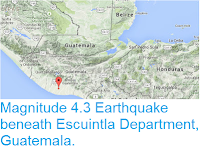The Instituto Nacional de Sismologia, Vulcanologia, Meteorologia, e Hidrologia in Guatemala has issued a warning to residents of villages near Mount Fuego, a stratovolcano (cone shaped volcano made up of layers of ash and lava)
that forms part of La Horqueta volcanic complex in the southern part of
the country, following a series of large eruptions on Friday 5 May 2017. The volcano produced a number of ash columns that reached between 10 and 12 km above sea level, which drifted to the south and west, causing ashfalls in a number of communities. This was accompanied by a number of loud explosions, and new lava flows on the upper parts of the mountain.
Ash column over Mount Fuego on 5 May 2017. Ivonne Gordillo/Publinews.
Fuego
has been more-or-less constantly active at some level since records in
the area began (circa 1524). It forms part of La Horqueta volcanic
complex, which also includes the Acatenango volcano to the north, a
complex volcano with at least five separate vents, the complex siting on
the site of the ancient Meseta volcano, which is thought to have
collapsed following a major volcanic episode about 8500 years ago,
causing a debris flow that reached the sea, 50 km away.
The approximate location of Mount Fuego. Google Maps.
The
volcanoes of Guatemala, and Central America in general, are fed by the
subduction of the Cocos Plate beneath the Caribbean Plate along the
Middle American Trench, which runs roughly parallel to the southwest
coast of the isthmus. As the Cocos Plate sinks into the Earth, it passes
under Central America, which lies on the western margin of the
Caribbean Plate. As this happens it is heated by the friction and the
heat of the planet's interior, causing the sinking plate to partially
melt. Some of the melted material then rises through the overlying
Caribbean Plate as magma, fuelling the volcanoes of Central America.
See also...
Follow Sciency Thoughts on Facebook.








